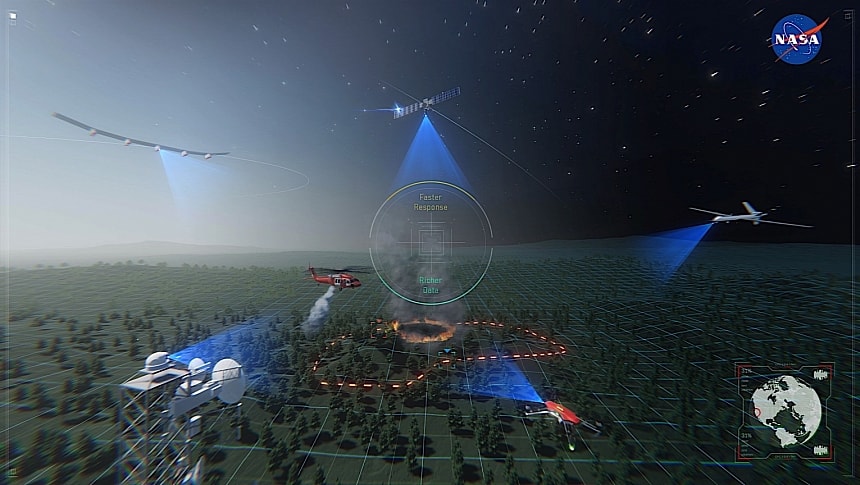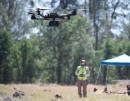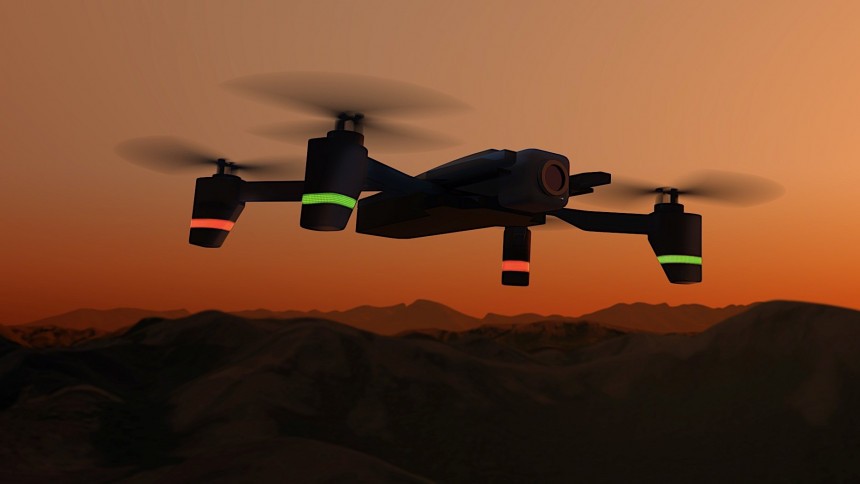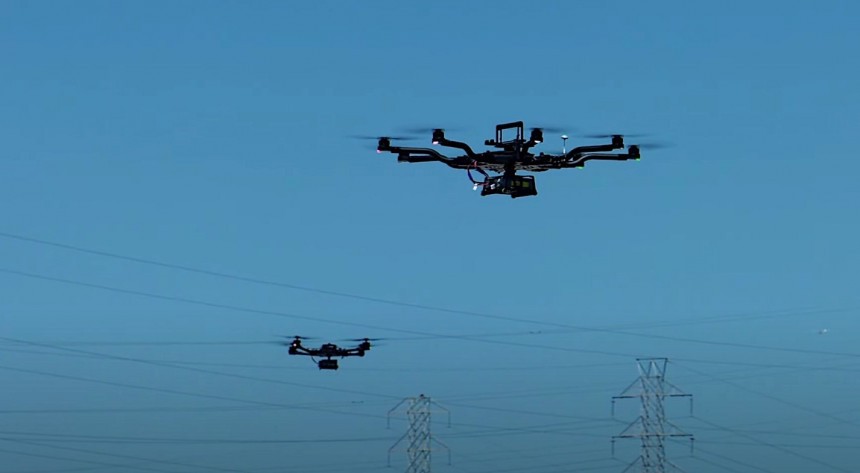Wildfires are some of the most devastating natural events that plague our world with worrying regularity. According to the U.S. Forest Service, the United States faces thousands of wildfires each year (there were over 55,000 of them in 2023 alone), destroying millions of acres of forest and grassland and releasing a huge amount of carbon dioxide into the atmosphere.
Not only that, but wildfires are also extremely expensive to put down. According to estimates, the U.S. spends $2.9 billion over a five-year period on suppression means alone.
As the climate continues to change it's likely these events will become even more widespread and devastating, in all respects. And that has some American agencies worried that the current means of fighting wildfires might no longer be enough.
As things are now wildfires are most of the time attacked with airplanes in the sky and boots on the ground. Both of these methods are extremely dangerous, as they imply the presence of human beings in close vicinity to the fire.
When it comes to aerial firefighting operations, things are not as great as they should be. Although effective to some degree, this method implies dangerous aerial maneuvers with bulky aircraft, and can only be used when there is enough visibility for the pilots to fly in and out of the area safely.
There may be a way, though, to give wildfire fighting a more potent punch, and make such operations much cheaper to conduct. And it has to do with drones. After all, if these things are capable of fighting wars they must surely be more than capable of taking on fires in remote areas. And they'll be a lot cheaper than current means, too.
That's what NASA believes, and it believes this so wholeheartedly that it even created a project meant to look into how drones could be integrated into such operations. A project more and more organizations are getting involved with.
The project is called Advanced Capabilities for Emergency Response Operations (ACERO) and it was kicked off about a year ago. In a nutshell, it is an effort intended to "develop new airspace access and traffic management concepts and technologies to support wildland fire operations."
What that means is NASA is looking into everything from drone design to the safe integration of this kind of aircraft into the dynamic airspace over a fire.
The advantages of using drones over crewed aircraft for this kind of task are obvious. First of all, because drones can be remotely controlled, no humans (or a lot fewer of them) will be placed in harm's way, regardless of the operation being conducted.
Then, depending on the size and type of drones, they can be used for anything from monitoring of the fire to the actual suppression. Crew coordination, situational awareness, and even the delivery of gear to the ground crews in need of aid are also possible when using drones. In some cases, they could also double as communication relays in areas where the connectivity is limited.
All these operations could be conducted in a continuous manner over the fire's lifetime, something that is not always possible with current means.
NASA is also taking into account the use of drones for controlled burns. Those would be fires that are set intentionally by experts in a bid to remove the dead brush wildfires often feed on to grow in size.
As things are today, most of the controlled burns being performed across the U.S. require a combination of crewed helicopters and ground crews. Drones are used in some cases, but in a very limited role. That makes this an operation that is both expensive and dangerous, something the use of drones on a large scale could easily mitigate. On top of it all, drones could allow controlled burns on a much larger scale than is possible now.
To make sure it advances its ACERO program, NASA announced last week the creation of a joint team with the Federal Aviation Administration (FAA) to look into the development of wildland fire technology.
The team is called Wildland Fire Airspace Operations and it will work over the next four years on devising the "set of technologies to prevent, monitor, and fight these growing fires more effectively."
NASA did not specifically say which kind of drones it targets for use in such a capacity but does say that whatever advancements the team achieves will inform a future concept of wildfire fighting.
Drones will be tested in the field at some point in the future, but not only their firefighting capabilities will be put through their paces. To be effective, these things will also have to make sure they don't come in conflict with other aircraft operations taking place in the area. So a special kind of safety software will have to be devised under the ACERO project.
As the climate continues to change it's likely these events will become even more widespread and devastating, in all respects. And that has some American agencies worried that the current means of fighting wildfires might no longer be enough.
As things are now wildfires are most of the time attacked with airplanes in the sky and boots on the ground. Both of these methods are extremely dangerous, as they imply the presence of human beings in close vicinity to the fire.
When it comes to aerial firefighting operations, things are not as great as they should be. Although effective to some degree, this method implies dangerous aerial maneuvers with bulky aircraft, and can only be used when there is enough visibility for the pilots to fly in and out of the area safely.
There may be a way, though, to give wildfire fighting a more potent punch, and make such operations much cheaper to conduct. And it has to do with drones. After all, if these things are capable of fighting wars they must surely be more than capable of taking on fires in remote areas. And they'll be a lot cheaper than current means, too.
The project is called Advanced Capabilities for Emergency Response Operations (ACERO) and it was kicked off about a year ago. In a nutshell, it is an effort intended to "develop new airspace access and traffic management concepts and technologies to support wildland fire operations."
What that means is NASA is looking into everything from drone design to the safe integration of this kind of aircraft into the dynamic airspace over a fire.
The advantages of using drones over crewed aircraft for this kind of task are obvious. First of all, because drones can be remotely controlled, no humans (or a lot fewer of them) will be placed in harm's way, regardless of the operation being conducted.
Then, depending on the size and type of drones, they can be used for anything from monitoring of the fire to the actual suppression. Crew coordination, situational awareness, and even the delivery of gear to the ground crews in need of aid are also possible when using drones. In some cases, they could also double as communication relays in areas where the connectivity is limited.
All these operations could be conducted in a continuous manner over the fire's lifetime, something that is not always possible with current means.
As things are today, most of the controlled burns being performed across the U.S. require a combination of crewed helicopters and ground crews. Drones are used in some cases, but in a very limited role. That makes this an operation that is both expensive and dangerous, something the use of drones on a large scale could easily mitigate. On top of it all, drones could allow controlled burns on a much larger scale than is possible now.
To make sure it advances its ACERO program, NASA announced last week the creation of a joint team with the Federal Aviation Administration (FAA) to look into the development of wildland fire technology.
The team is called Wildland Fire Airspace Operations and it will work over the next four years on devising the "set of technologies to prevent, monitor, and fight these growing fires more effectively."
NASA did not specifically say which kind of drones it targets for use in such a capacity but does say that whatever advancements the team achieves will inform a future concept of wildfire fighting.
Drones will be tested in the field at some point in the future, but not only their firefighting capabilities will be put through their paces. To be effective, these things will also have to make sure they don't come in conflict with other aircraft operations taking place in the area. So a special kind of safety software will have to be devised under the ACERO project.












